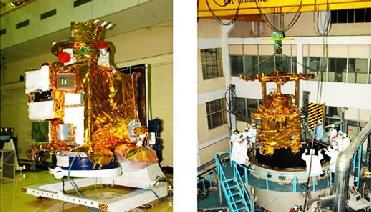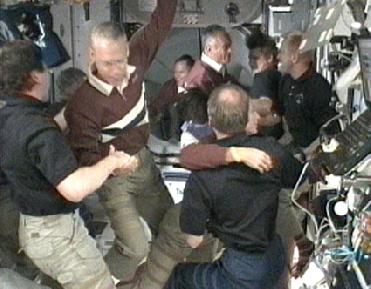
Chandrayaan: India's first mission to the moon. Photo Credit: ISRO
PANAJI (PTI): India's maiden Rs 400 crore moon mission Chandrayaan-1 was Sunday terminated, about one year before the odyssey's expected end, after ISRO failed to restore the snapped communication link with the satellite.
The Indian Space Research Organisation (ISRO) while announcing that the planned two-year lunar mission, launched amid a national euphoria on October 22 last year, has been formally called off said it would set up a high level committee to probe the abrupt end.
"We don't have contact with the spacecraft and we had to terminate the mission," a visibly disappointed ISRO chief G Madhavan Nair told reporters here.
The mission was abandoned early Sunday shortly after radio contact with the craft was abruptly lost at 0130 HRS.
ISRO tried to send the commands but the space vehicle was not able to respond. "The power signals which go to the computer systems failed."
Nair said the malfunction in computers on-board the spacecraft led to the failure in communications. "We tried to recover the communications for the entire day."
The ISRO chief was talking to reporters on the eve of the start of the eighth international conference on Low Cost Planetary missions.
Nair however put up a brave face to say the mission was a great success and 95 per cent of its objective was completed.
"We could collect a large volume of data, including 70,000 images of the moon."
He also said that India has already initiated discussions with USA and Russia to use their radars to track the spacecraft which is revolving in the orbit, at an altitude of 200 kms.
Nair said the snags in Chandrayaan-I would not result in delay of Chandrayaan II. "There are some marginal corrections that would be applied for the mission," he said.
When asked about the responsibility for the abrupt end, Nair quipped, "only I am responsible," as per the best tradition of ISRO.
"Today we are disappointed with the development. But have managed to get the large volume of data. We went through that and are contended with the results," Nair said conceding that it will not be possible to retrieve the spacecraft.
"The mission was a great success. Before the launch we had set up success criterias and technology objectives. We have found that all the instruments on the spacecraft worked satisfactorily and entire scientific instruments have performed that is how we could collect large volume of data."
He said more detailed cause for the failure could not be ascertained in the absence of telemetry signals which helps to point the cause through correlation process.
"More than 70,000 images of the moon were captured. It showed the most important region of surface. We had joint experiments with NASA scientists wherein the signals from our spacecraft were sent to US satellite which were captured successfully," Nair added.
Nair said that the environment around the moon was much more severe than what we anticipated.
He however took comfort from the fact that Chandrayaan-I lasted nearly one year.
"We survived for 315 days which is a good record. Many such experiments have burnt within a month in the past," he stated.
Replying to a question, the ISRO chief said the mission was not carved for two years but instead the spacecraft was designed with a two-year lifespan.
"After seeing the spacecraft in difficulty, we tried to maximise its utility," Nair said.
ISRO scientists said the spacecraft is 200 kms away from the moon and it will take 1,000 days to spiral in and hit the lunar surface.
Nair said ISRO is constantly in touch with the international partners of Chandrayaan-I and are very much happy with the data collected during the mission.
He said that he has not spoken to the prime minister personally. "But I informed PMO. I will be talking to him somewhere next week," he added.
 Previous Article
Previous Article Next Article
Next Article












The Indian Air Force, in its flight trials evaluation report submitted before the Defence Ministry l..
view articleAn insight into the Medium Multi-Role Combat Aircraft competition...
view articleSky enthusiasts can now spot the International Space Station (ISS) commanded by Indian-American astr..
view article